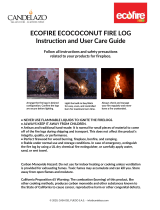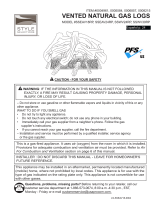Remington REM-L240BNO-V Operating instructions
- Category
- Fireplaces
- Type
- Operating instructions
This manual is also suitable for
Remington REM-L240BNO-V is a vented gas log appliance with a 55,000 BTU/Hr input rating, making it suitable for use in larger fireplaces. It is designed for use with natural gas and features a match ignition system for easy lighting. The appliance meets all applicable safety standards, including ANS Z21.84-2012 and ANS Z21.60-2017/CSA2.26-2017 when used with the LP Conversion Kit (REM-LPK100A). The REM-L240BNO-V can be installed in a solid-fuel burning fireplace with a working flue and constructed of noncombustible material.
Remington REM-L240BNO-V is a vented gas log appliance with a 55,000 BTU/Hr input rating, making it suitable for use in larger fireplaces. It is designed for use with natural gas and features a match ignition system for easy lighting. The appliance meets all applicable safety standards, including ANS Z21.84-2012 and ANS Z21.60-2017/CSA2.26-2017 when used with the LP Conversion Kit (REM-LPK100A). The REM-L240BNO-V can be installed in a solid-fuel burning fireplace with a working flue and constructed of noncombustible material.




















-
 1
1
-
 2
2
-
 3
3
-
 4
4
-
 5
5
-
 6
6
-
 7
7
-
 8
8
-
 9
9
-
 10
10
-
 11
11
-
 12
12
-
 13
13
-
 14
14
-
 15
15
-
 16
16
-
 17
17
-
 18
18
-
 19
19
-
 20
20
Remington REM-L240BNO-V Operating instructions
- Category
- Fireplaces
- Type
- Operating instructions
- This manual is also suitable for
Remington REM-L240BNO-V is a vented gas log appliance with a 55,000 BTU/Hr input rating, making it suitable for use in larger fireplaces. It is designed for use with natural gas and features a match ignition system for easy lighting. The appliance meets all applicable safety standards, including ANS Z21.84-2012 and ANS Z21.60-2017/CSA2.26-2017 when used with the LP Conversion Kit (REM-LPK100A). The REM-L240BNO-V can be installed in a solid-fuel burning fireplace with a working flue and constructed of noncombustible material.
Ask a question and I''ll find the answer in the document
Finding information in a document is now easier with AI
Related papers
Other documents
-
 ecofire ECOCO6 User manual
ecofire ECOCO6 User manual
-
 ProCom Heating SSEAV18RP User manual
ProCom Heating SSEAV18RP User manual
-
Emberglow ACC16 Installation guide
-
Barton 95038-H1 User manual
-
Emberglow SO18NGDC Installation guide
-
Emberglow CRO24NGDC Installation guide
-
Pleasant Hearth VL-AA24D User manual
-
Pleasant Hearth VL-WO30D Installation guide
-
Vermont Castings 4080 User manual
-
Vermont Casting 2997 User manual





















